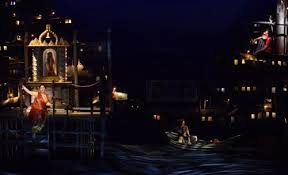London Coliseum, 16 June 2014
The underwater scenes caused something of a sensation when the production was new four years ago and they are certainly still very impressive. As the brief orchestral introduction unfolds the whole of the Coliseum stage becomes the sea, with gentle sunlight piercing the deep as three divers swim down to collect pearls. They return at key moments, either below or above the water’s surface, and all of the settings reflect the close relationship between the sea and the people. The mix of live performers with subtle video is extremely effective, and far better than video alone.
Within this environment the love triangle is worked out, constantly harking back to earlier events at the temple when the three protagonists had first met.
George von Bergen is not only a virile and dynamic Zurga but a convincing leader of the village. His emotional problems in act three are clearly defined without stretching credibility. It is only a pity that the ending of the opera is so weak musically that it fails to give him the emotional clarity the character needs.
John Tessier’s Nadir is not quite the outsider and his relationship with Zurga is strongly developed as the first act progresses. The famous duet, while beautifully sung here, is also given the uncomfortable edge it rightly needs to carry the narrative forward. The focus of their concern is Sophie Bevan’s Leila. There was an apology at the start as she had been ill earlier in the day but there was little sign of this in her warm and sympathetic approach to the part. She makes it clear that she is an unwilling priestess, as she dangles her feet off the pier.
The only other character is Barnaby Rea’s commanding High Priest, though the production allows him to disappear in the third act, weakening the conclusion.
Most of the evening is beautifully and sensitively lit, though there are moments when the lighting of the chorus was flat and over-bright. Though the choral singing is strong throughout the set does not help them. The long thin horizontal walkways mean the chorus have to shuffle in in single file from the sides and are effectively stuck where they are. Where a Sri Lankan crowd should be volatile and constantly on the move, as the music indicates, these people are static throughout. Needless to say there is no dancing and no room for it.
Jean-Luc Tingaud gives us a full romantic sound from the pit and moves the narrative along while allowing us to indulge in the many purple passages.

